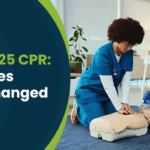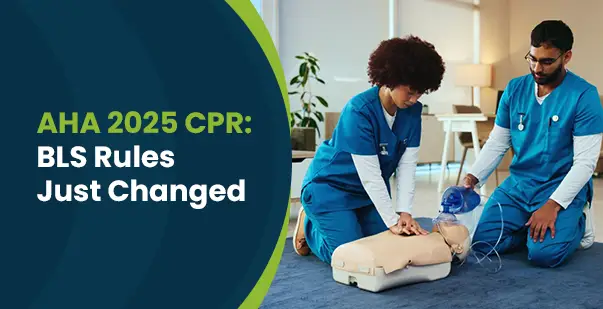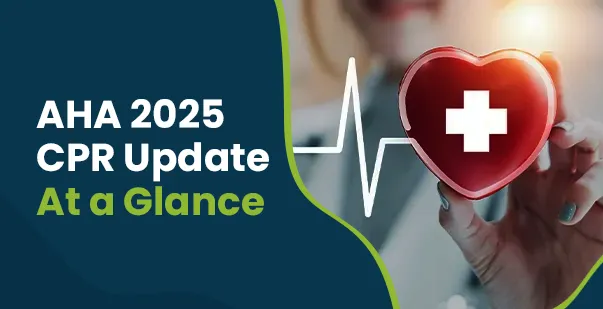Brain cells start to perish within approximately 4 to 5 minutes without oxygen supply, so every minute counts if a person is in respiratory arrest.
Respiratory arrest, if untreated, can quickly escalate to cardiac arrest, so timely management is the key to survival. As a medical provider, knowledge of pathophysiology, early warning signs and symptoms, and step-by-step emergency response protocols is indispensable.
This manual delves into the types, etiology, clinical presentation, and evidence-based techniques to treat respiratory arrest, preparing clinicians and trained responders with the information necessary to respond decisively when seconds matter.
What is respiratory arrest?
Respiratory failure is a medical emergency in which a person stops breathing. Unlike causing respiratory distress, respiratory arrest means that breathing has stopped completely. The condition can lead to cardiac arrest if not treated immediately. Keep reading to explore more about the causes, respiratory failure symptoms, and management of respiratory arrest.
What are the types of respiratory arrest?
Respiratory arrest can be caused by various underlying physiological derangements, and knowing the type is essential for successful intervention. From a clinical standpoint, respiratory arrest can be divided into three broad categories depending upon the etiology of compromised gas exchange: hypoxic, hypercapnic, and mixed. Each type represents a different mechanism either an absence of oxygen, excess carbon dioxide, or both and poses different diagnostic and management challenges.
1. Hypoxic respiratory arrest
Hypoxic respiratory arrest takes place when there is insufficient oxygen in the blood to sustain life. Various conditions can cause this type of arrest, which impairs or blocks the airway. It can also block the ability of the lungs to exchange oxygen effectively.
Examples: The examples include choking, when a foreign object prevents oxygen from reaching the lungs. Another example includes asthma attacks, which reduce the amount of oxygen that can enter the lungs.
2. Hypercapnic respiratory arrest
Hypercapnic respiratory arrest takes place when it causes a buildup of carbon dioxide in the blood due to inadequate respiration. This condition is a result of the body’s ability to expel carbon dioxide effectively. Examples include chronic obstructive pulmonary disease and opioid overdose.
3. Mixed respiratory arrest
Mixed respiratory arrest is a blend of hypoxia and hypercapnia. This can occur in several conditions without optimum carbon dioxide and oxygen updates. The examples include severe pneumonia and advanced neuromuscular disorders.
6 Common Causes of Respiratory Arrest
Various medical conditions can cause respiratory arrest, which impedes normal breathing. Here are some common causes:
- Airway obstruction: The blockage is a common cause of respiratory arrest in adults and children. It can lead to reactions such as swelling of the airway.
- Respiratory diseases: Advanced COPD can limit airflow. It causes respiratory failure. Severe asthma attacks often restrict the airways to the point where it becomes difficult to breathe.
- Infections: Severe infections can lead to inflammation and fluid accumulation. This weakens the ability to exchange gas.
- Neurological disorders: Damage to the respiratory centers of the brain can challenge normal breathing patterns. Severe head trauma can have an impact on the brain’s ability to control breathing.
- Drug overdose: The drugs can impact the central nervous system and slow down breathing. Overdoses can damage the respiratory system.
- Cardiac arrest: A sudden heart attack can cause respiratory arrest due to inadequate delivery of circulation and oxygen.
Read More: High-quality CPR: Overview, Components, and Technology
Who Is at Risk of Respiratory Arrest? Key Contributing Factors
Although respiratory arrest may follow suddenly, it usually precedes a recognizable risk factor that gradually compromises respiratory function. Knowing these risk factors is important for early detection, preventive treatment, and prompt intervention.
From chronic respiratory illness and age-related risks to lifestyle and acute medical conditions, many conditions are known to increase the risk of respiratory arrest. Awareness of such risks enables healthcare professionals and high-risk individuals to proactively take measures in minimizing avoidable events.
Pre-existing respiratory conditions:
If you have any preexisting respiratory diseases, such as asthma, it can cause respiratory arrest.
Age:
Age is a major factor, as infants and young children are prone to obstruction. Additionally, elderly individuals are also at a higher risk, especially with the prevalence of chronic diseases.
Smoking:
According to the Centers for Disease Control and Prevention, smoking is responsible for 90% of all deaths caused by lung cancer. Smoking is harmful, causing damage to lung tissue. This leads to conditions such as COPD, increasing the risk of respiratory failure.
Substance abuse:
Abuse of drugs raises the risk of respiratory arrest. It may be due to the depressant effects it causes on the central nervous system.
Medical history:
Allergic reactions increase the risk of airway obstruction and respiratory arrest.
Severe infections:
Individuals exposed to infections such as sepsis or pneumonia are at higher risk.
Trauma:
Severe physical trauma can disrupt the normal functioning of the respiratory system.
Training You Can Trust for Real Emergencies
Enroll in BLS Training
Respiratory Distress vs. Failure vs. Arrest: What’s the Difference?
Respiratory compromise is a continuum, ranging from mild impairment of breathing to full cessation. Discrimination among respiratory distress, respiratory failure, and respiratory arrest is critical for on-time and proper clinical intervention. Each is a progressively more severe impairment of respiratory function, having unique physiological characteristics and urgency. Identification of where a patient lies on this spectrum allows for better diagnosis, triage, and treatment planning—oftentimes dictating outcomes in time-limited emergencies.
| Feature | Respiratory Distress | Respiratory Failure | Respiratory Arrest |
| Breathing | Yes, but difficult | Yes, but not effective | No breathing at all |
| Oxygen Levels | Slightly lower than normal | Too low (hypoxemia) | Critically low |
| Carbon Dioxide | Normal | Too high | Rapid buildup |
| Consciousness | Usually alert or anxious | May be confused or sleepy | Unconscious or unresponsive |
| Urgency | Needs medical attention | Needs urgent treatment | Emergency – needs immediate CPR |
| Examples | Asthma, pneumonia | COPD, drug overdose | Choking, severe trauma |
| Treatment | Give oxygen and treat the underlying cause (e.g., medication for asthma or infection) | Provide breathing support with a ventilator and hospital care | Start CPR, clear airway, call emergency services immediately |
1. Respiratory distress
Respiratory distress occurs when an individual experiences difficulty breathing. Several factors can cause asthma, pneumonia, and other respiratory illnesses. Symptoms include rapid breathing and shortness of breath. The body is able to maintain adequate gas exchange. However, the effort required has increased.
2. Respiratory failure
Respiratory failure is a severe condition compared to respiratory distress. It occurs when the respiratory system cannot maintain adequate gas exchange. This leads to low oxygen levels and high carbon dioxide levels.
3. Respiratory arrest:
Respiratory arrest is a severe condition and takes place when breathing stops completely. This decreases oxygen levels and increases carbon dioxide in the body. This is harmful and can lead to cardiac arrest. You need immediate intervention to restore breathing and avoid harmful outcomes.
Detailed signs that medical professionals would observe include
- Cyanosis: This is a discoloration of the lips, skin, and fingernails. This is caused by a lack of oxygen in the blood.
- Absence of breath sounds: While using a stethoscope, healthcare providers will note the absence of normal breath sounds. You can hear abnormal sounds such as wheezing and gurgling.
Medical professionals use these respiratory depression symptoms to diagnose respiratory arrest and start interventions.
Recognizing respiratory depression
Here are some warning signs that take place after a full arrest:
- Shallow breathing: The breathing rate may drop significantly. As a result, breaths may become shallow. This indicates oxygen insufficiency.
- Confusion or drowsiness: The person may appear tired. This can be a sign of an inadequate oxygen supply.
- Fatigue: Extreme tiredness is another sign to look for. This signals that the oxygen levels are low.
How do you manage a respiratory event?
When respiratory arrest occurs, it is crucial to take immediate action to prevent any outcomes, such as brain death. Both healthcare providers and laypersons are crucial in managing respiratory events. Here are the steps to follow:
Healthcare provider protocols
- Call for help: This is the first action to take to manage a respiratory arrest. This assures professional help.
- Initiate CPR: You must start resuscitation immediately. CPR is useful in maintaining circulation and oxygenation. This includes rescue breaths and chest compressions.
Airway management steps
- Bag-valve mask: Use a bag-valve mask and offer ventilation. Seal the mask properly over the patient’s face and deliver breaths.
- Incubation considerations: Consider endotracheal intubation to secure the airway and offer ventilation. A skilled healthcare provider performs this procedure.
- Medications: A few medications are necessary to manage respiratory arrest. This includes drugs that address the underlying causes. Healthcare providers must follow industry guidelines and protocols to ensure proper dosages and regimens.
Post-resuscitation care
Once the patient has stabilized, you must ensure post-resuscitation care. This involves supportive care, continuous monitoring, and care.
Caregivers and public actions
If you are a caregiver, you must call out emergency services. A quick response significantly improves outcomes.
CPR instructions
It is beneficial for everyone to seek training in CPR. Links to reputable resources help provide valuable information.
Automated external defibrillators
AEDs are crucial devices that help save lives during medical emergencies such as sudden cardiac arrest. Laypersons use this and can provide life-saving defibrillation before emergency services arrive.
What are the prevention strategies?
Preventing respiratory arrest involves managing chronic conditions and treating infections. Here are some prevention strategies:
- Managing chronic conditions: Make sure that you regularly monitor and treat chronic, respiratory, and cardiac conditions.
- Treat infections: Effective and prompt treatment prevents complications that might cause a sudden respiratory arrest.
- Modify lifestyle: Suit your lifestyle in a way that promotes healthy lifestyle choices.
- Reduce smoking: Smoking is dangerous, so seek help to reduce the risk.
- Manage your weight: Maintain a healthy weight to help prevent conditions. This may lead to respiratory arrest.
Resources for at-risk individuals
Offering support and resources for individuals at risk can prevent respiratory events.
- Support groups: Support groups for conditions such as heart disease or COPD can offer motivation and valuable help.
- Monitoring devices: Devices that monitor respiratory function can alert individuals to potential issues.
Conclusion
It is crucial to recognize and offer prompt action to manage respiratory arrest. Immediate intervention can prevent severe complications, such as death. Recognizing the signs early, such as changes in consciousness, and initiating appropriate measures, such as CPR, can improve outcomes. Effective treatment by healthcare providers stabilizes the patient.
Training You Can Trust for Real Emergencies
Enroll in BLS Training
FAQs
1. What is your approach to a patient in respiratory arrest?
Call emergency services, clear the airway to remove any obstructions, start CPR with chest compressions and rescue breathing. Employ a bag-valve mask or give assisted ventilation if trained and resume until professional assistance arrives.
2. What is the first aid management for respiratory arrest?
Call emergency services immediately, open the airway and check for breath. If not breathing, begin CPR, give rescue breaths and chest compressions. Use an AED if present and trained to do it.
3. What to do when a patient has respiratory distress?
Assist the person to sit up and remain calm. Encourage slow, deep breathing, if possible. Call for medical assistance if the symptoms become worse or do not get better.









